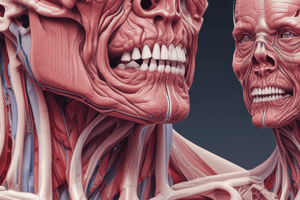Podcast
Questions and Answers
Quel est le rôle principal du système nerveux ?
Quel est le rôle principal du système nerveux ?
Le système nerveux associe le système de réception et de transmission de l'information (afférent) et le système de commande de la réponse (efférent).
Quelles sont les deux parties du système nerveux périphérique ?
Quelles sont les deux parties du système nerveux périphérique ?
- Sensoriel et moteur
- Somatique et végétatif (correct)
- Central et périphérique
- Cranien et spinal
Les dendrites transmettent les impulsions.
Les dendrites transmettent les impulsions.
False (B)
Quel est le rôle principal des cellules de Schwann ?
Quel est le rôle principal des cellules de Schwann ?
Les nerfs craniens sont responsables de l'innervation de la tête et du cou.
Les nerfs craniens sont responsables de l'innervation de la tête et du cou.
Quel est le nerf principal responsable de l'innervation sensitive de l'extrémité céphalique ?
Quel est le nerf principal responsable de l'innervation sensitive de l'extrémité céphalique ?
Comment les nocicepteurs sont-ils activés ?
Comment les nocicepteurs sont-ils activés ?
Décrivez le rôle des nocicepteurs dans le processus inflammatoire.
Décrivez le rôle des nocicepteurs dans le processus inflammatoire.
Quels sont les trois facteurs qui contribuent à la perception de la douleur?
Quels sont les trois facteurs qui contribuent à la perception de la douleur?
La douleur est une expérience unique et subjective, elle est différente pour chacun.
La douleur est une expérience unique et subjective, elle est différente pour chacun.
Qu'est-ce que l'allodynie ?
Qu'est-ce que l'allodynie ?
Qu'est-ce que l'hyperalgésie ?
Qu'est-ce que l'hyperalgésie ?
Associez les différents types de fibres nerveuses à leur description :
Associez les différents types de fibres nerveuses à leur description :
Quel est le rôle du système modulateur descendant dans la perception de la douleur ?
Quel est le rôle du système modulateur descendant dans la perception de la douleur ?
Le système du "Gate control" permet d'atténuer la douleur en utilisant des informations tactiles.
Le système du "Gate control" permet d'atténuer la douleur en utilisant des informations tactiles.
Qu'est-ce que l'endorphine ?
Qu'est-ce que l'endorphine ?
Flashcards
Qu'est-ce que la physiologie?
Qu'est-ce que la physiologie?
L'étude des fonctions et des propriétés des organes et des tissus des êtres vivants.
Définition de la douleur selon l'IASP
Définition de la douleur selon l'IASP
Une expérience sensorielle et émotionnelle désagréable associée à une lésion tissulaire réelle ou potentielle, ou décrite en ces termes.
Quelle est la double nature de la douleur ?
Quelle est la double nature de la douleur ?
Un signal d'atteinte à l'intégrité de l'organisme (douleur aiguë) mais également une maladie neurologique à part entière (douleur chronique).
Définition de la nociception.
Définition de la nociception.
Signup and view all the flashcards
Particularité des douleurs oro-faciales.
Particularité des douleurs oro-faciales.
Signup and view all the flashcards
Stimulus algogène
Stimulus algogène
Signup and view all the flashcards
Perception de la douleur
Perception de la douleur
Signup and view all the flashcards
Définition du système nerveux
Définition du système nerveux
Signup and view all the flashcards
Définition du système nerveux central (SNC)
Définition du système nerveux central (SNC)
Signup and view all the flashcards
Définition du système nerveux périphérique
Définition du système nerveux périphérique
Signup and view all the flashcards
Définition du système nerveux somatique
Définition du système nerveux somatique
Signup and view all the flashcards
Définition du système nerveux végétatif
Définition du système nerveux végétatif
Signup and view all the flashcards
Structure du neurone
Structure du neurone
Signup and view all the flashcards
Définition de la synapse
Définition de la synapse
Signup and view all the flashcards
Définition de la gaine de myéline
Définition de la gaine de myéline
Signup and view all the flashcards
Le nerf trijumeau
Le nerf trijumeau
Signup and view all the flashcards
Nerf maxillaire (V2)
Nerf maxillaire (V2)
Signup and view all the flashcards
Nocicepteur
Nocicepteur
Signup and view all the flashcards
Transducteurs
Transducteurs
Signup and view all the flashcards
Récepteur TRPV1
Récepteur TRPV1
Signup and view all the flashcards
Canaux sodiques voltage-dépendants
Canaux sodiques voltage-dépendants
Signup and view all the flashcards
Sensibilisation des nocicepteurs
Sensibilisation des nocicepteurs
Signup and view all the flashcards
Rupture du périneurium
Rupture du périneurium
Signup and view all the flashcards
Modification du phénotype des nocicepteurs
Modification du phénotype des nocicepteurs
Signup and view all the flashcards
Fibres Aδ
Fibres Aδ
Signup and view all the flashcards
Fibres C
Fibres C
Signup and view all the flashcards
Phénomène d'hyperalgésie
Phénomène d'hyperalgésie
Signup and view all the flashcards
Réflexion sur la transmission du message douloureux
Réflexion sur la transmission du message douloureux
Signup and view all the flashcards
Matrice de la douleur
Matrice de la douleur
Signup and view all the flashcards
Cortex somato-sensoriel, cortex insulaire, cortex cingulaire, thalamus, cortex préfrontal
Cortex somato-sensoriel, cortex insulaire, cortex cingulaire, thalamus, cortex préfrontal
Signup and view all the flashcards
Système modulateur descendant
Système modulateur descendant
Signup and view all the flashcards
Substance grise périaqueducale
Substance grise périaqueducale
Signup and view all the flashcards
Classification physiopathologique des douleurs
Classification physiopathologique des douleurs
Signup and view all the flashcards
Douleurs nociceptives
Douleurs nociceptives
Signup and view all the flashcards
Study Notes
Module 14: Appareil manducateur
- The module is about the masticatory system
- Objectives include defining pain, nociception, and pain components of the face.
- Identifying the particularities of the sensitive innervation of the face is also an objective.
- Describing the stages involved in the peripheral pathway of nociception is another objective.
- Identifying different types of receptors of fibres involved in pain is included in the objectives.
- Describing the influence of inflammation on pain is included as an objective.
- Describing the stages involved in the central pathway of pain is included in the objectives.
- Listing modulation systems of facial pain is in the objectives.
- Defining the characteristics of orofacial pain semiology is included in the objectives.
- Classifying orofacial pain based on physiopathological origin and treatments is in the objectives.
Physiologie orofaciale
- The topic is about the physiological orofacial aspects.
- The content covers the physiology of pain.
Physiologie
- The subject is part of biology focused on the functions and properties of living organisms' organs and tissues
- It details the progression from atoms to molecules to organs and systems.
Objectifs
- Defining pain, nociception, and pain components of the face.
- Identifying the particularities of sensory innervation of the face.
- Describing the steps in the peripheral pathway of nociception.
- Identifying the different types of pain receptors.
- Describing the effect of inflammation on pain.
- Describing the steps in the central pathway of pain.
- Listing facial pain modulation systems.
- Defining the characteristics of orofacial pain semiology.
- Classifying orofacial pain based on physiopathological origin and treatments.
Plan
- Defines pain and nociception.
- Covers psycho-physiological aspects of pain, including nociceptive stimuli, sensations, and associated emotional responses.
- Details craniofacial innervation and nervous system aspects.
- Introduces pain pathways and neurobiology of orofacial pain.
- Covers the semiology of orofacial pain.
- Presents a classification of physiopathological orofacial pains.
Introduction
- Pain is the primary reason people seek dental and medical care.
- Pain is a complex symptom signaling damage to the body's integrity.
- It can be acute or, in more severe cases, chronic.
Processus douleur
- A diagram depicts pain as an overlap of sensation and emotion.
L'art et la peinture
- Art, particularly painting, has been a means of conveying themes of suffering.
Plan
- Introduces definitions of pain and nociception.
- Details psycho-physiological aspects, including nociceptive stimuli, sensations, and associated reactions.
- Covers the innervation and orofacial characteristics.
- Investigates pain pathways and neurobiological orofacial pain aspects.
- Discusses oral and facial pain semiology
- Provides a physiopathological classification of orofacial pain.
I. Définitions
- The IASP (International Association for the Study of Pain) defines pain as a sensory and emotional experience that is unpleasant, or is described in those terms, being either real or potential tissue damage.
II. Aspects psychophysiologiques
- Nociceptive stimuli
- Nociceptive sensations and pain perception
- Sensations, reactions, and perception relating to pain
III. Innervation et particularité orofaciales
- Review of the nervous system.
- Cranial nerve innervation of the head area.
IV. Voies de la douleur
- Peripheral mechanisms involved in nociception
- Neurobiology of orofacial pains
III. Les voies de la douleur
- Nociceptors and fibres of pain in different body areas.
- Pain pathways in the spinal cord
- Role of the thalamus
- Cortical projections
IV. Voies de la douleur
- Peripheral mechanisms involved in nociception
- Neurobiological aspect of orofacial pain
III. Les voies de la douleur
- Review of nociceptor receptors and fibres involved in pain.
- Details of spinal cord pain pathways.
- Role and function of the thalamus.
- Cortical projections for pain.
IV. Voies de la douleur
- Peripheral mechanisms involved in nociception
- Neurobiological aspects of orofacial pain
IV. Voies de la douleur
- Nociceptors and related fibres of the pain response.
- Spinal cord pain pathway elements.
- Thalamus in pain pathway function
- Cortical pain projections
IV. Voies de la douleur
- Peripheral mechanisms linked to nociception.
- Aspects of orofacial pain neurobiology.
IV. Voies de la douleur
- Peripheral mechanisms of nociception.
- Neurobiology of orofacial pain.
IV. Les voies de la douleur
- Nociceptors and pain fibers.
- Spinal cord pathways
- Thalamus
- Cortical projections
IV. Les voies de la douleur
- Peripheral pain mechanisms.
- Neurobiology of orofacial pain.
IV. Mécanismes périphériques impliqués dans la nociception
- Nociceptors and their types.
- Factors influencing nociceptors during inflammation.
- Conclusions regarding the first neuron associated with pain.
IV. Mécanismes périphériques impliqués dans la nociception
- Peripheral nociceptor mechanisms
- Nociceptors and their types
- Influence of inflammation on nociceptors.
IV. Voies de la douleur
- Peripheral mechanisms related to nociception.
- Neurobiology of orofacial pain.
V. Sémiologies des douleurs oro-faciales
- Forms of orofacial pain from a physiopathological perspective.
- Pain processes.
- Types of pain.
- Pain components.
- Relation between pain and stress responses.
- Relation between pain and sleep patterns.
- Assessment and evaluation of pain.
V. Semiologie des douleurs oro-faciales
- Physiopathological forms of oral and facial pain.
- Pain process.
- Types of pain.
- Describing components of pain.
- Describing pain in relation to stress.
- Describing pain in relation to sleep.
- Evaluation of pain.
VI. Classification physiopathologique des douleurs oro-faciales
- Classifying orofacial pain based on physiopathological origin and treatments.
V. Classification physiopathologique des douleurs oro-faciales
- Classification of orofacial pain types based on physiopathology, including classifications for nociceptive, neuropathic, nociplastic and mixed pains.
V. Classification physiopathologique des douleurs oro-faciales
- Classify different orofacial pains based on their physiopathological characteristics.
V. Classification physiopathologique des douleurs oro-faciales
- Classifying orofacial pain types based on physiopathological properties.
- Classification scheme for various types of oral and facial pain, such as nociceptive pain, neuropathic pain, nociplastic pain and mixed pain.
V. Classification physiopathologique des douleurs oro-faciales
- Classification of orofacial pain types, such as nociceptive, neuropathic, nociplastic, and mixed pain.
V. Classification physiopathologique des douleurs oro-faciales
- Physiopathological classification of orofacial pain.
V. Classification physiopathologique des douleurs oro-faciales
- Types of orofacial pain, including nociceptive, neuropathic, and mixed types
V. Classification physiopathologique des douleurs oro-faciales
- Orfacial pains, including nociceptive, neuropathic, nociplastic, mixed pains
V. Classification physiopathologique des douleurs oro-faciales
- Classification scheme for various types of orofacial pains
Studying That Suits You
Use AI to generate personalized quizzes and flashcards to suit your learning preferences.





